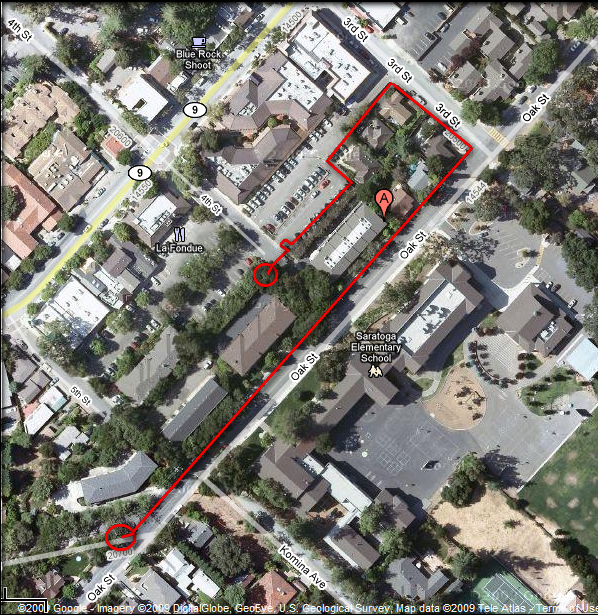August 2009 Saratoga, CA -
Faithful readers will know that each day I walk from my townhouse down to the Blue Rock Shoot for coffee and my newspaper. What you don't know is that on the way back I have to step over a little stream of ants running across the sidewalk. Little reddish-brown ones. I like to call them Argentine ants, but I'm not an expert. Last week I decided to see what they were up to.
On the right the trail led to a large oak tree. The ants went up into the tree, swarmed around one old hole and then trailed up a branch to an older hole that years ago was a branch. Ok, they live in the tree.
In the other direction I followed the little guys down the parking lot about 50 yards until we came to an empty drink can. Wow, that's quite a ways for these little guys to go. They must be searching the entire parking lot at night.
Then I noticed that they were not in the drink can. The trail went beyond the can. I followed them out of the parking lot towards some dumpsters; they did not stop there. Out to the street, up the street, around the corner and then THREE LONG BLOCKS further, I finally came to a place where the ants disappeared into some pine needles. When I kicked the duff a bunch of ants ran around. Double wow, this is a long way away. Check out the route:

This trail disappears during the day, but is there each morning. When the street sweeper comes by it takes them about three days to re-establish the connection. This is a long way for little ants. I clocked a couple of them and it took about 30 seconds for them to travel 5 feet. Extrapolating, this route takes them about 2 hours, one way.
This long trail made me wonder what the entire range is for this one nest. To them this route is a linear walk - if they had GPS they'd take a more direct path. So unfolding this I estimate this one nest to have the following area in its search pattern:

Holy cow! Imagine meeting someone on Vickery looking at an ant trail and wondering where the ants come from. What would they think when you said, "oh, probably over on St. Charles." They'd think you were nuts.
Of course, it is possible that the ant nest range is constrained by other ant nests and forced to fold back on itself. I have some big black ants in my yard. Do they ignore each other? Do the black ants travel less? I've see massive ant movements between two oak trees just across the street from me. Maybe my ants met those ants and everyone decided to stay on their own side of the road? I'm thinking of capturing a few ants from across the street and introducing them to my ants. If my ants accept them, then I'd believe they are all part of one big family.
September 2009 -
One night I decided to test my one big happy family story - it isn't true. One night I went out and found that the ants across the street were very active. A big wide trail ran between the two oak trees. The ants were climbing over a bunch of leaves. I picked up one and put it into a tupperware container. Back on my side of the street I shook a few of the "far side" ants into the ant trail on my side. At first I thought they were all getting along. My ants touched antennae with the visitors. Then my ants gathered around the new comers like a welcome group. It was hard to see what was going on, but the next thing I know the visiting ants are in little pieces. I guess they're not all friends.
More experiments... I wonder how the trail is established each night. Does one nest head out for the other? I want to sit in front of my house. When the first ants show up from one direction I'll run ahead of them to see if the other side is coming to meet them in the middle. [Update: In June 2012 I observed this for the colony across the street.]
Another question: how do the ant colonies remember the way. Sure the ants leave scents. What if those are disrupted? Is there some solvent I could pour on the trail area during the day that would erase whatever pheromone they leave? If so, what search pattern would they use to reestablish contact?
If we could... What would happen if one of these any colonies was taken intact and moved somewhere else? Without disturbing them. The time would come to set out for the other nest. Would they be lost looking for an existing pheromone trail? When they didn't find it would they execute a random search pattern? Or do they have some group knowledge of the trail and their search pattern would be more directed?
Do the same ants travel each night? I'd like to mark a bunch of ants one night as they leave one nest. Then watch the next several nights to see how long before the same ants come back again.
So many questions... too bad no one will pay me to look into these things.
Jim Schrempp is a sometimes freelance writer (only Vanity Press will publish his work) living in Saratoga, California. His writings have appeared on numerous pages on his own web site. The opinions expressed in this piece are those of the writer and do not necessarily represent those of anyone else (although Jim wishes more people shared his opinions)